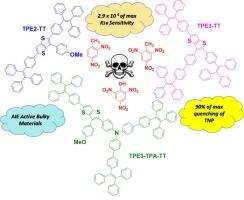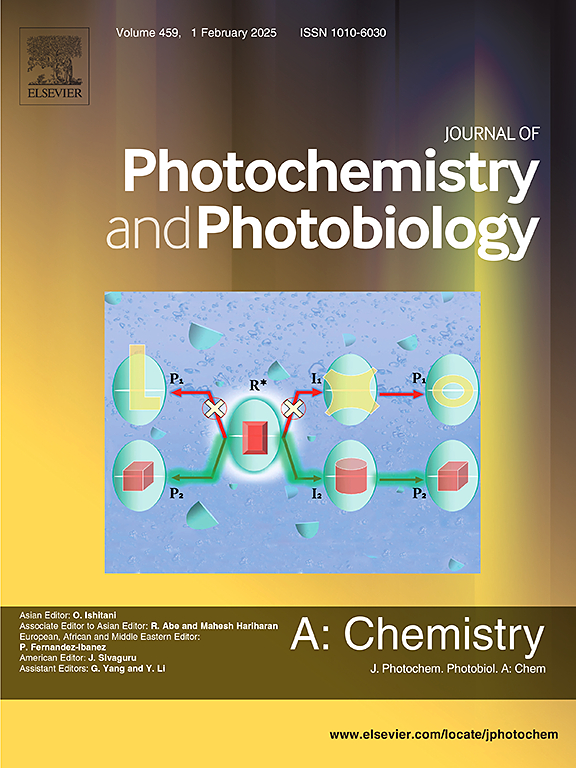Thienothiophene based AIE-Active bulky materials for sensitive explosive detection
IF 4.1
3区 化学
Q2 CHEMISTRY, PHYSICAL
Journal of Photochemistry and Photobiology A-chemistry
Pub Date : 2024-10-16
DOI:10.1016/j.jphotochem.2024.116095
引用次数: 0
Abstract
Sensors for selective and sensitive detection of nitroaromatic (NAC) explosives are of current interest for both national security and environmental protection. In this work, three thienothiophene based AIE active materials (TPE2-TT, TPE3-TT and TPE3-TPA-TT), possessing tetraphenylethylene and triphenylamine units, were designed and synthesized as chemosensors for sensitively detecting 2,4,6-trinitrotoluene (TNT), 2,4-dinitrotoluene (DNT) and trinitrophenol (TNP) explosives. Among the AIEgens, TPE3-TT demonstrated a maximum Stern-Volmer constant (Ksv) reaching to 2.9 x 104 M−1 by quenching response toward TNP. They exhibited vivid visual quenching on absorbent papers. Moreover, probe-explosive complex interactions and their mechanisms were investigated using density functional theory (DFT). Their remarkable properties indicated that TT based AIEgens are promising probes for sensitively detecting the explosives, which provided a new source of potential leading to new designs for detection of explosives.

基于噻吩的 AIE-Active 大体积材料用于灵敏的爆炸物检测
选择性灵敏检测硝基芳香族(NAC)爆炸物的传感器目前在国家安全和环境保护方面都备受关注。本研究设计并合成了三种基于噻吩噻吩的 AIE 活性材料(TPE2-TT、TPE3-TT 和 TPE3-TPA-TT),它们具有四苯基乙烯和三苯胺单元,可作为化学传感器灵敏地检测 2,4,6-三硝基甲苯(TNT)、2,4-二硝基甲苯(DNT)和三硝基苯酚(TNP)炸药。在这些 AIEgens 中,TPE3-TT 对 TNP 的淬火反应显示出最大的斯特恩-伏尔默常数(Ksv),达到 2.9 x 104 M-1。它们在吸水纸上表现出生动的视觉淬火。此外,还利用密度泛函理论(DFT)研究了探针-爆炸复合物的相互作用及其机制。它们的显著特性表明,基于 TT 的 AIEgens 是灵敏检测爆炸物的有前途的探针,这为爆炸物检测的新设计提供了新的潜力来源。
本文章由计算机程序翻译,如有差异,请以英文原文为准。
求助全文
约1分钟内获得全文
求助全文
来源期刊
CiteScore
7.90
自引率
7.00%
发文量
580
审稿时长
48 days
期刊介绍:
JPPA publishes the results of fundamental studies on all aspects of chemical phenomena induced by interactions between light and molecules/matter of all kinds.
All systems capable of being described at the molecular or integrated multimolecular level are appropriate for the journal. This includes all molecular chemical species as well as biomolecular, supramolecular, polymer and other macromolecular systems, as well as solid state photochemistry. In addition, the journal publishes studies of semiconductor and other photoactive organic and inorganic materials, photocatalysis (organic, inorganic, supramolecular and superconductor).
The scope includes condensed and gas phase photochemistry, as well as synchrotron radiation chemistry. A broad range of processes and techniques in photochemistry are covered such as light induced energy, electron and proton transfer; nonlinear photochemical behavior; mechanistic investigation of photochemical reactions and identification of the products of photochemical reactions; quantum yield determinations and measurements of rate constants for primary and secondary photochemical processes; steady-state and time-resolved emission, ultrafast spectroscopic methods, single molecule spectroscopy, time resolved X-ray diffraction, luminescence microscopy, and scattering spectroscopy applied to photochemistry. Papers in emerging and applied areas such as luminescent sensors, electroluminescence, solar energy conversion, atmospheric photochemistry, environmental remediation, and related photocatalytic chemistry are also welcome.

 求助内容:
求助内容: 应助结果提醒方式:
应助结果提醒方式:


